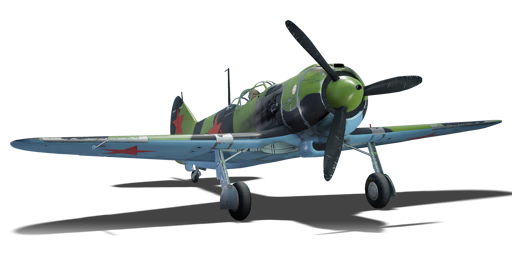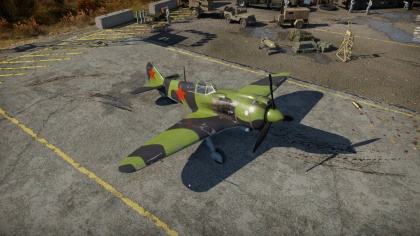La-5F
Contents
| This page is about the Russian fighter La-5F. For other versions, see La-5 (Family). |
Description
The La-5F is a rank II Soviet fighter
with a battle rating of 3.3 (AB/RB/SB). It was introduced in Update 1.35.
General info
Flight performance
The La-5F is a relatively heavy fighter which makes it a good candidate to perform Boom & Zoom tactics. Due to the reinforcements in its wings, it can execute rapid dives without the threat of breaking its wings. While limited turn engagements are possible under the right circumstances, excessive turning to include up to and past 180 degrees, will result in a significant amount of lost energy leaving the La-5F more times than nought, at the mercy of the enemy aircraft.
| Characteristics | Max Speed (km/h at 5,000 m) |
Max altitude (metres) |
Turn time (seconds) |
Rate of climb (metres/second) |
Take-off run (metres) | |||
|---|---|---|---|---|---|---|---|---|
| AB | RB | AB | RB | AB | RB | |||
| Stock | 569 | 548 | 9000 | 22.1 | 22.8 | 11.8 | 11.8 | 370 |
| Upgraded | 623 | 591 | 20.1 | 21.2 | 20.7 | 15.6 | ||
Details
| Features | ||||
|---|---|---|---|---|
| Combat flaps | Take-off flaps | Landing flaps | Air brakes | Arrestor gear |
| ✓ | ✓ | ✓ | X | X |
| Limits | ||||||
|---|---|---|---|---|---|---|
| Wings (km/h) | Gear (km/h) | Flaps (km/h) | Max Static G | |||
| Combat | Take-off | Landing | + | - | ||
| 0 | 310 | 470 | 470 | 270 | ~13 | ~13 |
| Optimal velocities (km/h) | |||
|---|---|---|---|
| Ailerons | Rudder | Elevators | Radiator |
| < 380 | < 380 | < 380 | > 341 |
| Compressor (RB/SB) | ||
|---|---|---|
| Setting 1 | ||
| Optimal altitude | 100% Engine power | WEP Engine power |
| 2,050 m | 1,540 hp | 1,870 hp |
| Setting 2 | ||
| Optimal altitude | 100% Engine power | WEP Engine power |
| 5,400 m | 1,330 hp | N/A |
Survivability and armour
- 55 mm Bulletproof glass - Windshield
- 66 mm Bulletproof glass (upgrades to 75 mm with "Armored glass" modification) - Behind pilot
- 8.5 mm Steel (upgrades to 10 mm with "Rear armor plate" modification) - Behind pilot
- Self-sealing fuel tanks (1 in each wing, 1 below the cockpit)
Armaments
Offensive armament
The La-5F is armed with:
- 2 x 20 mm ShVAK cannons, nose-mounted (170 rpg = 340 total)
Suspended armament
The La-5F can be outfitted with the following ordnance:
- Without load
- 2 x 50 kg FAB-50 bombs (100 kg total)
Usage in battles
Describe the tactics of playing in the aircraft, the features of using aircraft in a team and advice on tactics. Refrain from creating a "guide" - do not impose a single point of view, but instead, give the reader food for thought. Examine the most dangerous enemies and give recommendations on fighting them. If necessary, note the specifics of the game in different modes (AB, RB, SB).
Manual Engine Control
| MEC elements | ||||||
|---|---|---|---|---|---|---|
| Mixer | Pitch | Radiator | Supercharger | Turbocharger | ||
| Oil | Water | Type | ||||
| Controllable | Controllable Not auto controlled |
Controllable Not auto controlled |
Controllable Not auto controlled |
Separate | Controllable 2 gears |
Not controllable |
Modules
| Tier | Flight performance | Survivability | Weaponry | |
|---|---|---|---|---|
| I | Fuselage repair | Radiator | Armored glass | DZ-40 |
| II | Compressor | Airframe | ||
| III | Wings repair | Engine | Rear armor plate | Offensive 20 mm |
| IV | Engine injection | Cover | New 20 mm cannons | |
Pros and cons
Pros:
- Good rate of climb without sacrificing speed (depending on the angle of climb)
- 20 mm cannons can chew up enemy aircraft especially when hitting in the right places
- Good at evading fire from gunners, rolling and turning can usually get you in close enough to engage an enemy aircraft
Cons:
- 20 mm cannons only have 340 rounds of ammo
- Can be outmanoeuvred by other nations with more agile fighters, Spitfires especially notorious with their exceptional turn rates
- Head-on fights will usually result poorly in the La-5F with many other enemy aircraft with superior weapon configurations for head-on attacks
History
In early 1942, Semyon Lavochkin's LaGG-3 fighter was under threat of having its production cancelled, having proved itself to be a flawed fighter, underpowered and overweight. At the same time, Arkady Shvetsov faced a lack of demand for his M-82 radial engine, only successfully used by the Sukhoi Su-2 ground attack aircraft that was also in danger of being cancelled. The two designers met at a conference in Moscow, and Shvetsov agreed to help Lavochkin fit the M-82 engine to the LaGG-3 airframe. Mikhail Gudkov, one of the original designers of the LaGG-3, had already attempted to do the same thing, resulting in the Gu-82 fighter. However, he had delayed too long in getting the fighter into production, and by April 1942, Aleksander Yakovlev had succeeded in getting production of the LaGG-3 cancelled in favour of his Yak-7 fighter, effectively monopolising Soviet fighter production.
Lavochkin's OKB was, in the meantime, transferred to the backwaters of Tbilisi, Georgia and he and his team had to work almost illegally and in harsh conditions to modify the LaGG-3 for the M-82 engine. The radial engine was physically wider than the LaGG-3 fuselage cross-section, requiring skirting to attach the larger engine and to the fuselage, and the M-82 also had no space for an engine-mounted cannon, unlike the Klimov M-105. Thus, the updated armament changed to two 20 mm ShVAK cannon mounted on top of the engine. The new LaGG-3 M-82 (also known as the Samolyot 37 (Aircraft 37) or the Type 37) was completed in February 1942 and underwent test flights, with promising results despite problems with engine cooling. Its performance was better than any Soviet fighter then in service. Other issues revealed in testing consisted of: excessive control forces, oil leaks, and excessive weight, but these could not overshadow the LaGG-3 M-82's excellent performance, and it full-scale development began as the LaG-5. The first fully operational LaG-5s were delivered on 20 June 1942.
Series LaG-5s suffered from poor quality, which reduced performance considerably. As was revealed in the test flights, pilots found it to be a more difficult aircraft to fly than the Yak-1 or LaGG-3, but the radial engine enhanced protection during head-on attacks. Redesignated La-5 in September 1942, the new fighter faced its first important test during the battle of Stalingrad. It proved not to be enough to equal the Bf 109 F-4 and G-2 models but was considered capable of further improvement. Continuous improvements to the La-5 would eventually lead to the La-5F, La-5FN, and finally the La-7, among some of the most excellent Soviet fighters of the Great Patriotic War.
In-game description
The M-82 initially had two operational modes: the so-called takeoff overdrive which allowed it to reach 1,700 hp, and its rated power mode which amounted to 1,330-1,350 hp. However, it could operate in overdrive mode for only 5-10 minutes. By the autumn of 1942, the A.D. Shvetsov design bureau had managed to upgrade the engine, giving it the ability to operate constantly in overdrive mode. In practice, this meant a significant addition to the aircraft's power output.
From December 1942, the La-5 began to be equipped with the M-82F engine. At the same time, the aircraft's notation received the letter "F" (forsirovannyj, or supercharged).
Apart from its powertrain, the La-5N received a number of other upgrades aimed at increasing its flight and combat characteristics. In particular, the aircraft's overall weight was reduced.
The aircraft's armament remained the same as that of the La-5 Type 37.
All the aircraft's radio equipment underwent changes; apart from the RSI-4 receiver, now every second airplane in the series had to be equipped with a transmitter, and every third with an RPK-10 fixed-loop radio compass.
Air vents were installed in front of the cockpit windshield on both sides, to provide cockpit ventilation.
From the spring of 1943, the La-5F began to be produced with a lowered fuselage spine fairing and a convex drop-shaped cockpit. The armored headrest on the pilot's seat was swapped with bullet-proof glass.
This and the improved quality of the plexiglass gave the pilot an excellent all-round view. An emergency release system was fitted to the cockpit canopy in order to ensure that if the plane was shot down, the stiff canopy would not prevent the pilot from jumping out of the plane and parachuting to safety.
The La-5F was superior in all respects to its predecessor, the La-5, particularly at low altitudes, where it had a speed advantage of up to 40 km/h. Its climbing rate and operating conditions for the pilot had also been improved.
Production of La-5F Type 39 continued until the end of 1943. The La-5F appeared in large quantities in the Kuban region, at Leningrad and at Velikiye Luki. In total, 4,150 were built, including the La-5F Type 37 with a fuselage fairing.
Media
Excellent additions to the article would be video guides, screenshots from the game, and photos.
See also
Links to the articles on the War Thunder Wiki that you think will be useful for the reader, for example:
- reference to the series of the aircraft;
- links to approximate analogues of other nations and research trees.
External links
Paste links to sources and external resources, such as:
- topic on the official game forum;
- encyclopedia page on the aircraft;
- other literature.
| Lavochkin Design Bureau (Лавочкинa Опытное конструкторское бюро) | |
|---|---|
| LaGG-3* | I-301 · LaGG-3-4 · LaGG-3-8 · LaGG-3-11 · LaGG-3-23 · LaGG-3-34 · LaGG-3-35 · LaGG-3-66 |
| La-5/7 | La-5 · La-5F · La-5FN · La-7 · Dolgushin's La-7 · La-7B-20 |
| La-9/11 | La-9 · La-11 |
| Jet Fighters | La-15 · La-174 · La-200 |
| Export | ␗La-9 · ␗La-11 |
| Captured | ▀La-5FN |
| *Lavochkin-Gorbunov-Gudkov (Лавочкин-Горбунов-Гудков), head designer V. P. Gorbunov | |
| USSR fighters | |
|---|---|
| I-15 | I-15 WR · I-15 M-22 · I-15 M-25 · I-15bis · Krasnolutsky's I-15bis |
| I-153 M-62 · Zhukovsky's I-153-M62 · I-153P | |
| I-16 | I-16 type 5 · I-16 type 10 · I-16 type 18 · I-16 type 24 · I-16 type 27 · I-16 type 28 · I-180S |
| I-29 | I-29 |
| I-185 | I-185 (M-71) · I-185 (M-82) |
| I-225 | I-225 |
| ITP | ITP (M-1) |
| MiG-3 | MiG-3-15 · MiG-3-15 (BK) · MiG-3-34 |
| LaGG | I-301 · LaGG-3-4 · LaGG-3-8 · LaGG-3-11 · LaGG-3-23 · LaGG-3-34 · LaGG-3-35 · LaGG-3-66 |
| La | La-5 · La-5F · La-5FN · La-7 · Dolgushin's La-7 · La-7B-20 · La-9 · La-11 |
| Yak-1/7 | Yak-1 · Yak-1B · Yak-7B |
| Yak-3 | Yak-3 · Eremin's Yak-3(e) · Yak-3P · Yak-3T · Yak-3U · Yak-3 (VK-107) |
| Yak-9 | Yak-9 · Yak-9B · Golovachev's Yak-9M · Yak-9T · Yak-9K · Yak-9U · Yak-9UT · Yak-9P |
| Other countries | ▂P-40E-1 · ▂P-47D-27 · ▂Hurricane Mk IIB · ▂Fw 190 D-9 · ▂Spitfire Mk IXc |
| P-39 | ▂P-39K-1 · ▂Pokryshkin's P-39N-0 · ▂P-39Q-15 |
| P-63 | ▂P-63A-5 · ▂P-63A-10 · ▂P-63C-5 |





